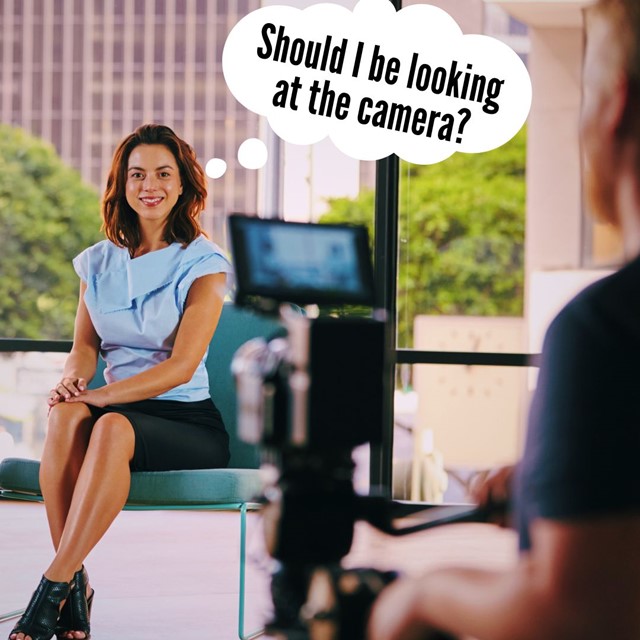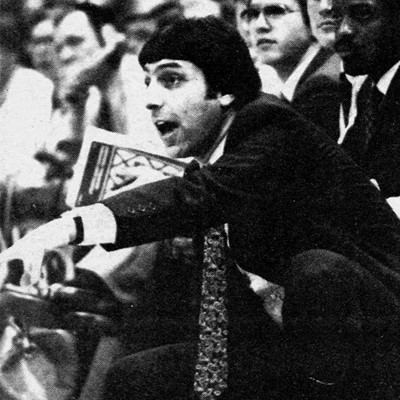
Being on camera is part of life for most of us now—recording dances on TikTok, meetings on Zoom, FaceTiming with the grandparents.
Yet, in media training, people still want to know: Where should I look when I'm on camera?
Let's walk through some eye contact considerations, so you can figure it out.
On camera interview, in person, with a reporter or host
For these interviews, keep you eyes on the person interviewing you. Think of it as a conversation the audience is watching, and you're not aware the viewers are there. Ideally, in a conversation, you give your undivided attention to the person you're talking to, yes?
In these types of interviews, be determined to keep your eyes directed at the interviewer all the way through—when you're talking, when they're talking, and during the spaces in between. Why? Because if you don't, then on the screen you'll appear to be cutting your eyes away to look at the viewer. You can seem nervous, uncertain, or shifty. Even small looks to the side can be distracting because they're magnified in the "box" we're watching you in.
On camera interview, at a location, no reporter is present
More and more frequently, videographers are sent to record TV news interviews in the field with no reporter or producer along. Or maybe you're interviewed for an internal video, and the videographer is also your in-house producer.
In many of these cases, the videographer sets up the camera, then instructs you to look at an imaginary interviewer to the side of the camera while the videographer asks you the questions.
This can feel uncomfortable, to say the least, and even make you feel ridiculous. Try to find something to fix your eyes on, as if that object (tree, chair, potted plant) is the interviewer. Keep your eyes there, even though the questions are coming in from a different direction. And don't be shy about asking for some direction from the videographer if you need guidance on where to look.
On camera interviewer, you are in one location, news anchor or host is in studio
You see these interviews all the time, especially now that Zoom is a routine way for podcasts and television programs to include guests. You look into the camera because that's "where" the interviewer is in these cases.
If you are at a local TV station, for example, they may have camera set up for this purpose (as in, “from the newsroom”)—and will tell you to look into the camera. Or for a live shot, the crew may set up a camera on location and tell you to talk with the anchor back at the studio.
If you're speaking with an interviewer by Zoom, remember: Their image on your screen is not where your eyes should go. You need to look at the little camera on your laptop or phone in order to appear to make eye contact with the interviewer.
Interview before a live audience that's being shared on video, too
Often, panel discussion and town hall meetings take place in front of a live audience but there are viewers watching a live stream of the event, as well. Where do you look then? This one's a little more complicated, and you may need to think it through.
You might choose to keep your attention on the interviewer. However, it can be very effective to start with the interviewer, look out at your in-person audience for the middle of the answer, then turn back to your interviewer as you come to the end of your answer.
If you are taking questions from the audience that's watching you on the screen, you might want to give your answer (or part of it) to the camera.
The decisions you make here are about how "right" it feels to acknowledge and address the viewing audience. Places you can look for ideas and examples are TV talk shows, corporate town hall meetings, and videos of conference panel discussions. You'll see a variety of approaches and can figure out with your team what's right for your project.
On camera, solo, and you have a message for the viewer
For these messages, look into the camera and speak as if you're talking to another individual, face to face. It feels good to viewers when you can move easily and naturally, smile, and express yourself just as you would if they were standing across from you.
Some people seem stiff on camera in these situations because they're worried about moving too much, concerned that what they do won't "fit in the box." That's fair—but in general, when you gesture naturally as you speak, it helps to energize your delivery even when you can't see the gestures on camera.
Remember: Practice and rehearsals can help
If you're not sure how you'll look on camera or need to hone your skills, it's something you can test and practice.
Set up your phone and tape a mock interview, one that mirrors the experience you’re prepping for. You'll see what looks good and what seems off, and that will help you feel ready when it's time to go on.
Learn more
For more tips to make Zoom appearances more effective, see this.
Find tips for better on camera delivery from one of our media pros, here.
For our general thoughts on the power of eye contact, look here.






